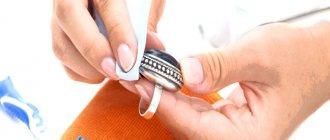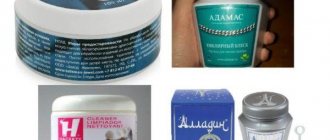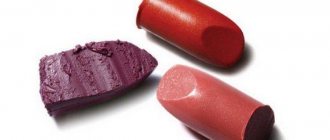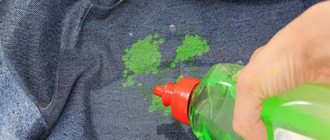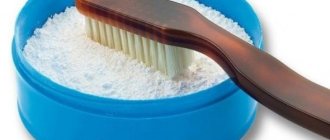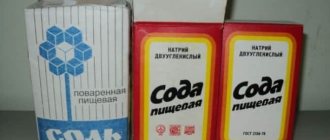Cutlery made from sterling silver is undoubtedly a chic addition to a holiday table. But improper handling of products can lead to black spots appearing on the metal. This happens because silver is a capricious metal and in order to maintain its shine and cleanliness, you need to remember the basic nuances of proper care, cleaning and storage. It is not necessary to buy special products for the cleaning procedure. Surely, in every home there are ingredients that can be used to return silverware to its former attractive appearance and extend the service life of the products.
Why does silverware darken?
Cleaning silverware begins when a change in its shade becomes noticeable.
The darkening of this metal is associated with exposure to sulfur, which, as a result of chemical reactions, causes the formation of a kind of plaque. The appearance of this metal largely depends on the substances that are in its composition. For example, pure silver is least susceptible to tarnish, however, due to its softness, practically nothing is produced from it. In order for this metal to acquire the required degree of hardness, copper is added to it.
Silverware is no exception and is also subject to the formation of a dark coating, so it needs to be cleaned periodically. It is worth noting that such household items cannot be washed in a dishwasher, which is why they may become completely unsuitable for use. In addition, you should not allow this metal to come into contact with rubber, which can also cause a deterioration in its appearance.
Why does metal turn black?
You may have noticed that metal darkens regardless of whether you wear it regularly, such as jewelry, or simply store it as tableware. Why is this happening?
The main reason is exposure to hydrogen sulfide. This gas is a permanent component of air. It is found everywhere: on the street, at home, and is often distinguished by rubber, polymers and even cardboard. The metal reacts with hydrogen sulfide, and as a result, a dark coating forms on the surface - silver sulfide. Humidity and high temperature accelerate the reaction rate.
Another reason is the same oxidation, but of copper. Silver utensils are covered with a greenish coating. The fact is that an alloy with copper is used for its manufacture. And the second, when interacting with an acidic environment, forms a greenish acetate.
There is an opinion that high-quality alloys do not darken. It is not true. Absolutely all silver items oxidize if you do not store them in a sterile chamber. The sample only affects the reaction rate. Conventionally, if the alloy is of low quality or contains impurities, it will darken faster.
Another popular belief: cold metal is an indicator of human health, and as soon as the owner becomes ill physically or spiritually, it darkens. This is only partly true. Silver jewelry does not have any magical properties. But illness or stress provoke changes in hormonal levels, sweating may increase, and body temperature may rise. The composition of secretions also changes, the amount of salt in sweat and hydrogen sulfide increases. And this directly affects the speed of the chemical reaction, and plaque forms much faster.
In addition, other factors influence the reaction: playing sports, as they provoke increased sweating and body temperature. Stress, which also affects the secretion of the skin glands and, as a result, increased sweat production. High ambient temperatures (for example, during the hot season, staying in a bathhouse or sauna) accelerate oxidation.
Chemicals, including household chemicals, also negatively affect jewelry. Sea water contains almost the entire periodic table, and, of course, affects metals. The process is also enhanced by air humidity.
How to clean silverware using folk remedies
Before cleaning silverware at home, you should remember that this metal is quite soft, and therefore does not accept the use of hard brushes and abrasives. Due to their impact, scratches may appear on its surface, which are very difficult to sand.
That is why, to give silver products pristine purity, you should use only pastes and gentle cleaning methods that will polish the coating without harming it.
Silver spoons and other utensils that have an ornament or insert made of another metal should be cleaned with chemicals with great care to prevent damage to the product.
Soap solution
- dilute any dishwashing detergent with a soap base in a container of water;
- soak the spoons in this solution for half an hour;
- rub the utensils with a sponge;
- wipe the silver dry.
Soda solution
Unlike pure soda, which can scratch the surface of cutlery made of silver, a solution of soda in water can be used. You just need to do this with special care:
- to prepare the solution, you need to boil water to which 4 tablespoons of soda have been added;
- You need to place cutlery in this container, and you must first place a sheet of aluminum foil on the bottom of the pan, which can be found in every kitchen;
- You need to keep the silver in this solution for 15 minutes;
- Now the devices can be removed, rinsed thoroughly with water and wiped with a dry cloth.
Ammonia
- you need to dilute the soap in water;
- add a few drops of ammonia;
- place cutlery in this composition and leave them to process for 25 minutes;
- after this you need to rinse them in cool water under the tap;
- Finally, drying of the devices with a cloth is required.
Ash or ashes
They have been used to clean silver since ancient times. They should be used this way:
- dilute a little ash in a small amount of water;
- take this mixture onto a small piece of sponge or cloth and rub it on silver spoons;
- This action easily removes the smallest particles of dirt.
Vinegar or citric acid
Both substances are allowed to be used only separately. In an aqueous solution of any of these substances, you need to soak silver items for an hour, and then, using a sponge, carefully remove softened dirt from them.
Salt
Silver items can be cleaned with rock salt. Take 200 ml of water into a glass and put one teaspoon of salt in it. Next, place silver spoons and forks in the saline solution and leave for 2.5 hours. After this time, pour the solution along with the products into an enamel bowl and place on the stove. Boil for 15 minutes. Then rinse in clean water and wipe dry.
Ammonia and toothpaste
This cleaning method is suitable for especially dirty items. Toothpaste should be used without grains or any other abrasive substances.
Take the statue a toothbrush, preferably a soft one, and apply toothpaste to it. Clean the products well on all sides, and then rinse them in clean and warm water and dip them in a solution of 10% ammonia. Soak the silverware in the ammonia for 15 minutes. Next, rinse again with water and dry thoroughly with a cloth.
Thick soap solution
The primary operation is to wash the silver in a thick soapy solution, preferably using dishwashing detergent. Thus, the fatty film and a lot of other contaminants are removed. For the best effect, especially if there is an ornament or design, engraving, the devices should be soaked in a soap solution at a temperature of about 50°C for half an hour. Afterwards, rinse thoroughly with a sponge. You can use synthetic hard sponges. Only without enthusiasm, even they can scratch soft metal.
Ready-made products for cleaning silverware
You can use special products that are designed to clean silver items. The advantage of such substances is their respect for the metal, because their composition is balanced in such a way that only a layer of contamination disappears from the surface, while the necessary and noble patina remains in place.
When choosing a product to be used for washing silverware, you should pay attention to the purpose of such a product. In addition, it is important to carefully follow the instructions on the packaging. As a rule, to wash cutlery, it is enough to soak spoons and forks in this mixture, and after some time, rinse them thoroughly.
Napkins for silver
Wipes designed specifically for cleaning silver items work quite effectively; they allow you to quickly shine a shine on spoons or forks. In addition, they are extremely convenient to use.
Sodium thiosulfate
If we talk about chemicals, we should remember about sodium thiosulfate, which can be purchased at the pharmacy. You need to use it as follows:
- first you need to remove the film of grease and dust from the surface of the silver; to do this, they need to be thoroughly washed in a solution of liquid soap;
- now you need to rinse the products;
- the drug itself must be dissolved in water;
- using a cloth or cotton pad, you need to apply the substance to the surface of spoons and forks;
- After this, you only need to rinse the devices in cool water and wipe them dry.
After such exposure, the surface of the silver spoons shines like new, and very little effort is expended in using this method.
Paste GOI
You can use GOI paste, which has the unique ability to polish any surface. How to clean devices with this composition? You need to do this:
- apply the paste to a small piece of material, after adding a little machine oil;
- Use this cloth to thoroughly polish the silver.
Which cleaning method to choose
It is best to clean silver with professional chemicals, for example, “Ultra Soft”, “Town walk” spray for small appliances, “Silbo” foam, “Hagerty” solution. But such products are quite expensive, so using them for constant cleaning is simply irrational.
There are many alternative, time-tested methods. But before you choose any specific method for yourself, you should know about some general rules for cleaning such cutlery.
How do experts clean silver items?
If a set of silverware is of considerable age and is a rarity and quite valuable, you should seek help from qualified specialists. The jewelry workshop employs people who know exactly how to clean silver spoons and forks, so as not only not to harm their appearance, but also to preserve their beauty for many years.
The process of cleaning silver items in jewelry workshops is as follows:
- Specialists use ultrasonic metal cleaning, which allows you to easily remove plaque and completely clean all inclusions of dirt. The effectiveness of this method is higher than all home methods combined.
- In addition, a steam generator is often used. This device works well with cutlery, which, in addition to plaque, contains on its surface traces of fat and residues of pastes used for polishing products of this kind. Moreover, this method gives a better result than the use of ultrasound.
- It is not enough to just clean cutlery made from silver. It is equally important to polish them thoroughly. For this, craftsmen use napkins soaked in special compounds, which give a sparkling shine to the products. A spoon or fork, cleaned in a workshop, will shine no worse than a new one.
Rules for storage, washing and use
Recommendations that allow you to preserve silver cutlery (including those with gold plating):
- after cleaning, items should sit for at least 3 days until a protective film forms;
- Products should be stored in a case with a velvet or other woven lining inside;
- devices must be kept away from sources of water, and the humidity level in the room must be normal;
- preventative cleaning should be carried out from time to time;
- You cannot use such devices for certain foods (eggs, mayonnaise, fish, etc.).
How to prevent silver from tarnishing
In order to keep your silverware in perfect shape, you should remember the factors that can contribute to the deterioration of its condition and the formation of plaque:
- After cleaning silver spoons or forks, it is important to store them in a case with soft material inside.
- The devices should not be crowded; if they touch each other, there will be a high probability of re-formation of plaque and patina. In order to avoid this, the devices are placed with cloth or paper.
- In addition, you can wrap the case itself with cling film to prevent oxygen and moisture from penetrating into it, which contribute to the creation of a microclimate favorable for the formation of various types of plaque.
- The humidity in the rooms where silverware is stored should not be high.
In order to prevent tarnishing of silver spoons or forks, it is important to follow the recommendations for their storage. Namely, keep them in cases where air and moisture cannot penetrate, carefully isolate the devices from each other and thoroughly clean them in a timely manner.
Rules of care
To prevent silver from darkening, you need to follow important care rules. The use of hard brushes, abrasive powders and metal brushes is not allowed. It is also recommended to keep the devices in a special case that will prevent moisture and constant contact with air.
How to store it correctly
It is recommended to store silver instruments in a special oil, but in this case some difficulties may arise with its use. For storage, you must choose the right place, which should be dry, cool and protected from sunlight. It is also necessary that the devices do not come into contact with other metal objects. This is the only way they will not darken and become covered with blackness.
Paste GOI
The easiest and most affordable method to polish the surface of silver cutlery. Many people have known GOI paste since childhood, or at least used it around the house, during hobbies, etc. This is a unique product for ultra-fine surface polishing.
It is easy and simple to use. It is enough to squeeze a little out of the tube or break off a piece in small shavings and apply it to a cotton cloth. For a better effect, apply a few drops of machine oil on top of the GOI paste, in which it easily dissolves.
Next, lightly rub the surface of the cutlery to a perfect shine. Even if there are abrasions or scratches, GOI paste will cope with the task better than other means and will return the former beauty to old silver objects.
Soda solution
Naturally, you cannot use dry soda or paste with a little added water, because this is a strong abrasive and can easily ruin silver surfaces. For cleaning, use a solution with soda. To do this, add about four tablespoons of soda to a saucepan with two liters of water brought to a boil. A sheet of kitchen foil is placed and pressed onto the bottom and silver cutlery is laid out.
After 15 minutes of such soaking, you can take out the items and, after they have cooled, wash them with soapy water, rinse and wipe dry.
